fuel CHEVROLET DURAMAX 2006 Owners Manual
[x] Cancel search | Manufacturer: CHEVROLET, Model Year: 2006, Model line: DURAMAX, Model: CHEVROLET DURAMAX 2006Pages: 100, PDF Size: 0.71 MB
Page 1 of 100
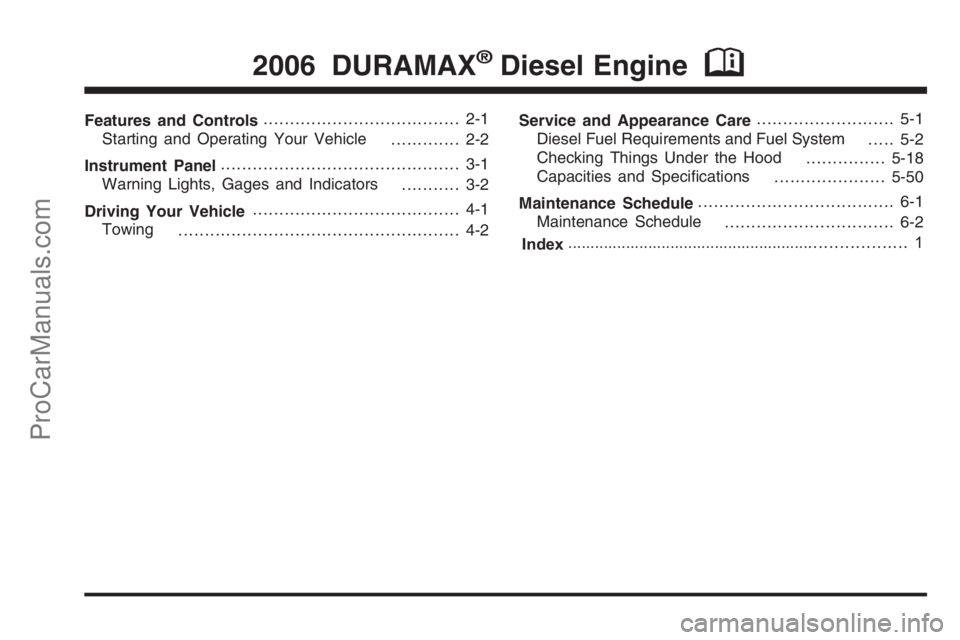
Features and Controls..................................... 2-1
Starting and Operating Your Vehicle ............. 2-2
Instrument Panel ............................................. 3-1
Warning Lights, Gages and Indicators ........... 3-2
Driving Your Vehicle ....................................... 4-1
Towing ..................................................... 4-2 Service and Appearance Care
.......................... 5-1
Diesel Fuel Requirements and Fuel System ..... 5-2
Checking Things Under the Hood ...............5-18
Capacities and Specifications .....................5-50
Maintenance Schedule ..................................... 6-1
Maintenance Schedule ................................ 6-2
2006 DURAMAX®Diesel EngineM
Index ......................................................................... 1
ProCarManuals.com
Page 3 of 100
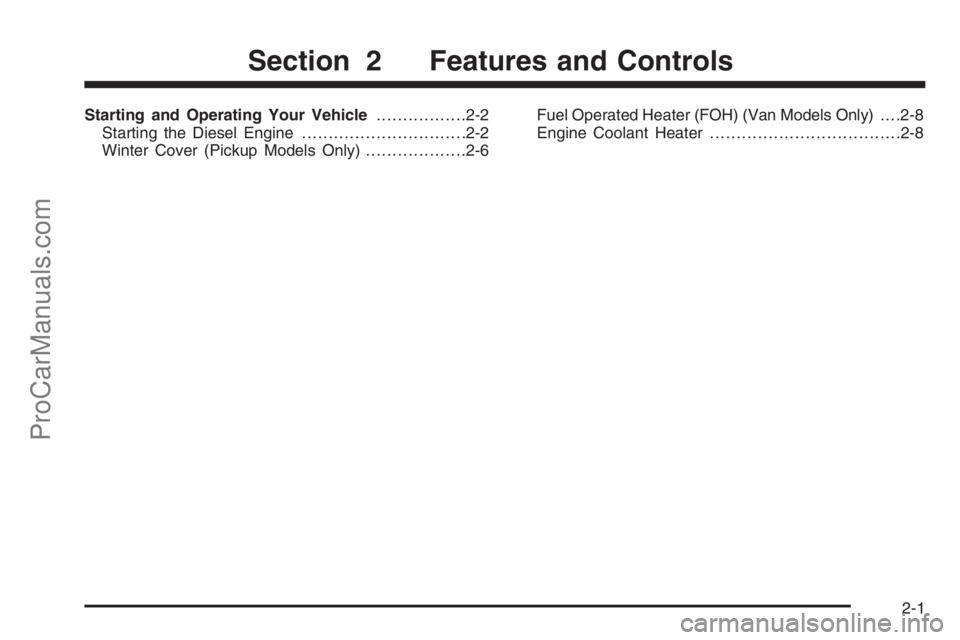
Starting and Operating Your Vehicle.................2-2
Starting the Diesel Engine...............................2-2
Winter Cover (Pickup Models Only)...................2-6Fuel Operated Heater (FOH) (Van Models Only). . . .2-8
Engine Coolant Heater....................................2-8
Section 2 Features and Controls
2-1
ProCarManuals.com
Page 4 of 100
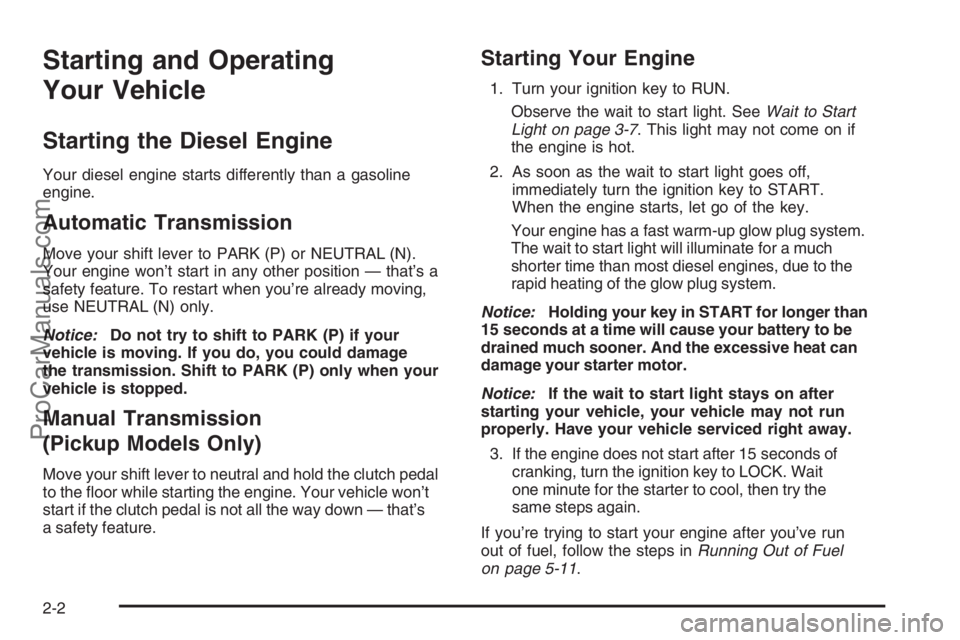
Starting and Operating
Your Vehicle
Starting the Diesel Engine
Your diesel engine starts differently than a gasoline
engine.
Automatic Transmission
Move your shift lever to PARK (P) or NEUTRAL (N).
Your engine won’t start in any other position — that’s a
safety feature. To restart when you’re already moving,
use NEUTRAL (N) only.
Notice:Do not try to shift to PARK (P) if your
vehicle is moving. If you do, you could damage
the transmission. Shift to PARK (P) only when your
vehicle is stopped.
Manual Transmission
(Pickup Models Only)
Move your shift lever to neutral and hold the clutch pedal
to the floor while starting the engine. Your vehicle won’t
start if the clutch pedal is not all the way down — that’s
a safety feature.
Starting Your Engine
1. Turn your ignition key to RUN.
Observe the wait to start light. SeeWait to Start
Light on page 3-7. This light may not come on if
the engine is hot.
2. As soon as the wait to start light goes off,
immediately turn the ignition key to START.
When the engine starts, let go of the key.
Your engine has a fast warm-up glow plug system.
The wait to start light will illuminate for a much
shorter time than most diesel engines, due to the
rapid heating of the glow plug system.
Notice:Holding your key in START for longer than
15 seconds at a time will cause your battery to be
drained much sooner. And the excessive heat can
damage your starter motor.
Notice:If the wait to start light stays on after
starting your vehicle, your vehicle may not run
properly. Have your vehicle serviced right away.
3. If the engine does not start after 15 seconds of
cranking, turn the ignition key to LOCK. Wait
one minute for the starter to cool, then try the
same steps again.
If you’re trying to start your engine after you’ve run
out of fuel, follow the steps inRunning Out of Fuel
on page 5-11.
2-2
ProCarManuals.com
Page 5 of 100
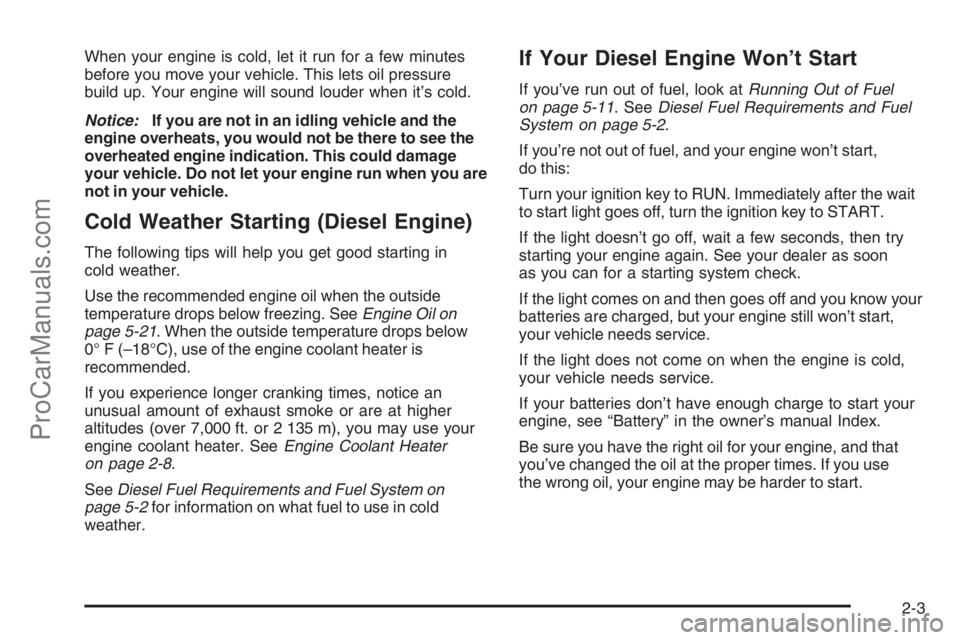
When your engine is cold, let it run for a few minutes
before you move your vehicle. This lets oil pressure
build up. Your engine will sound louder when it’s cold.
Notice:If you are not in an idling vehicle and the
engine overheats, you would not be there to see the
overheated engine indication. This could damage
your vehicle. Do not let your engine run when you are
not in your vehicle.
Cold Weather Starting (Diesel Engine)
The following tips will help you get good starting in
cold weather.
Use the recommended engine oil when the outside
temperature drops below freezing. SeeEngine Oil on
page 5-21. When the outside temperature drops below
0° F (–18°C), use of the engine coolant heater is
recommended.
If you experience longer cranking times, notice an
unusual amount of exhaust smoke or are at higher
altitudes (over 7,000 ft. or 2 135 m), you may use your
engine coolant heater. SeeEngine Coolant Heater
on page 2-8.
SeeDiesel Fuel Requirements and Fuel System on
page 5-2for information on what fuel to use in cold
weather.
If Your Diesel Engine Won’t Start
If you’ve run out of fuel, look atRunning Out of Fuel
on page 5-11. SeeDiesel Fuel Requirements and Fuel
System on page 5-2.
If you’re not out of fuel, and your engine won’t start,
do this:
Turn your ignition key to RUN. Immediately after the wait
to start light goes off, turn the ignition key to START.
If the light doesn’t go off, wait a few seconds, then try
starting your engine again. See your dealer as soon
as you can for a starting system check.
If the light comes on and then goes off and you know your
batteries are charged, but your engine still won’t start,
your vehicle needs service.
If the light does not come on when the engine is cold,
your vehicle needs service.
If your batteries don’t have enough charge to start your
engine, see “Battery” in the owner’s manual Index.
Be sure you have the right oil for your engine, and that
you’ve changed the oil at the proper times. If you use
the wrong oil, your engine may be harder to start.
2-3
ProCarManuals.com
Page 6 of 100
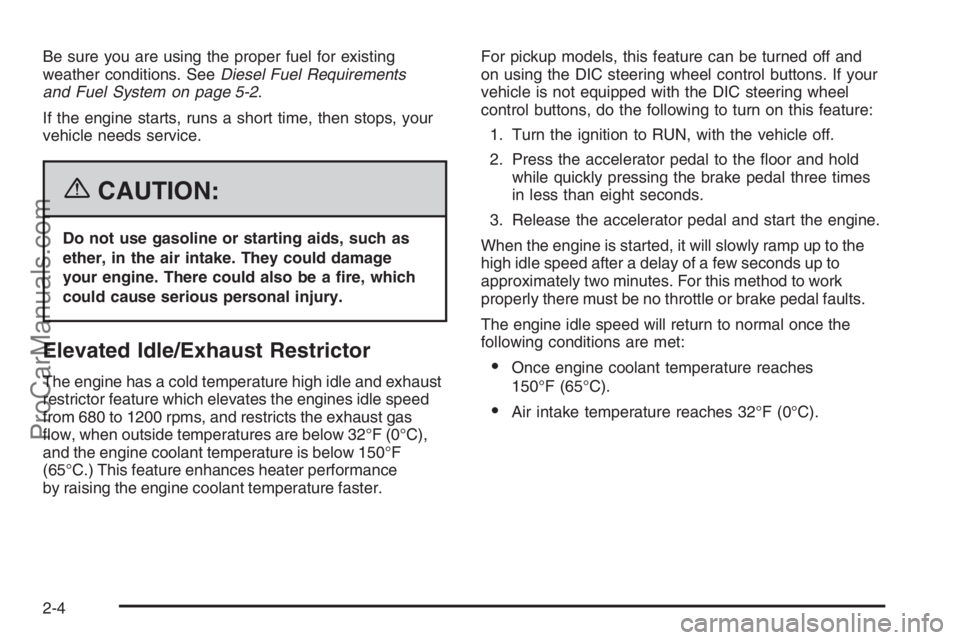
Be sure you are using the proper fuel for existing
weather conditions. SeeDiesel Fuel Requirements
and Fuel System on page 5-2.
If the engine starts, runs a short time, then stops, your
vehicle needs service.
{CAUTION:
Do not use gasoline or starting aids, such as
ether, in the air intake. They could damage
your engine. There could also be a �re, which
could cause serious personal injury.
Elevated Idle/Exhaust Restrictor
The engine has a cold temperature high idle and exhaust
restrictor feature which elevates the engines idle speed
from 680 to 1200 rpms, and restricts the exhaust gas
flow, when outside temperatures are below 32°F (0°C),
and the engine coolant temperature is below 150°F
(65°C.) This feature enhances heater performance
by raising the engine coolant temperature faster.For pickup models, this feature can be turned off and
on using the DIC steering wheel control buttons. If your
vehicle is not equipped with the DIC steering wheel
control buttons, do the following to turn on this feature:
1. Turn the ignition to RUN, with the vehicle off.
2. Press the accelerator pedal to the floor and hold
while quickly pressing the brake pedal three times
in less than eight seconds.
3. Release the accelerator pedal and start the engine.
When the engine is started, it will slowly ramp up to the
high idle speed after a delay of a few seconds up to
approximately two minutes. For this method to work
properly there must be no throttle or brake pedal faults.
The engine idle speed will return to normal once the
following conditions are met:•Once engine coolant temperature reaches
150°F (65°C).
•Air intake temperature reaches 32°F (0°C).
2-4
ProCarManuals.com
Page 10 of 100

Fuel Operated Heater (FOH)
(Van Models Only)
If your vehicle includes a fuel operated heater (FOH),
it will enhance heater performance and will reduce the
amount of time it takes to warm the inside of your vehicle
in cold conditions below 40°F (4.4°C). The fuel operated
heater is installed in the frame rail on the driver’s side of
the vehicle and uses diesel to warm up the engine
coolant, which finally warms up the passenger’s cabin
air. The FOH works automatically, depending on the
fuel level, engine coolant temperature and outside air
temperature. It works only with the engine running.
Engine Coolant Heater
In very cold weather, 0°F (−18°C) or colder, the engine
coolant heater can help. You’ll get easier starting
and better fuel economy during engine warm-up.
Usually, the coolant heater should be plugged in a
minimum of four hours prior to starting your vehicle.
To Use the Engine Coolant Heater
1. Turn off the engine.
2. Open the hood and unwrap the electrical cord.
The cord is located in the engine compartment,
on the passenger’s side of the vehicle, near the
right side engine mount.
3. Plug it into a normal, grounded 110-volt AC outlet.
{CAUTION:
Plugging the cord into an ungrounded outlet
could cause an electrical shock. Also, the
wrong kind of extension cord could overheat
and cause a �re. You could be seriously injured.
Plug the cord into a properly grounded
three-prong 110-volt AC outlet. If the cord
will not reach, use a heavy-duty three-prong
extension cord rated for at least 15 amps.
2-8
ProCarManuals.com
Page 11 of 100
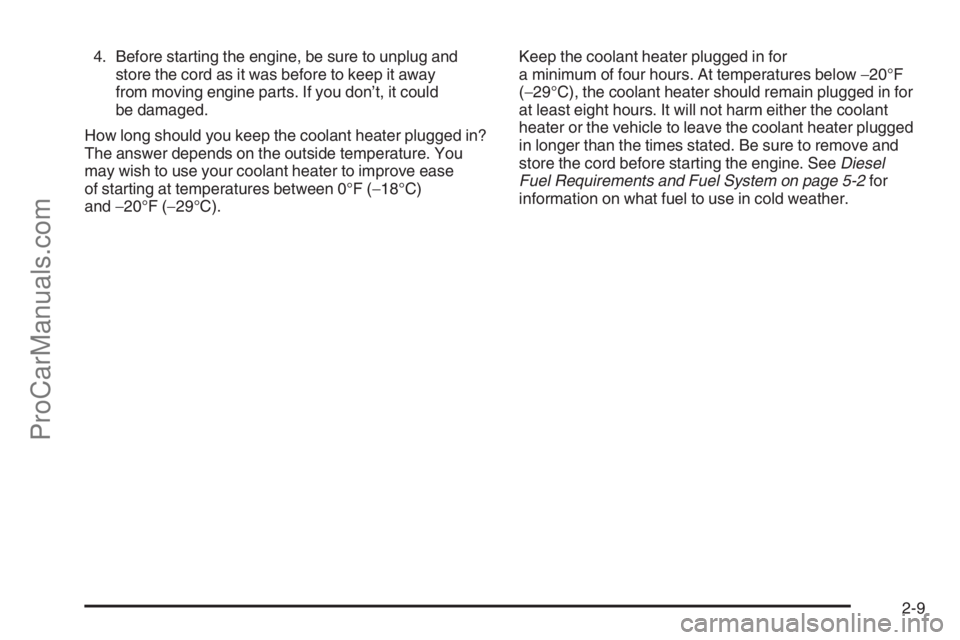
4. Before starting the engine, be sure to unplug and
store the cord as it was before to keep it away
from moving engine parts. If you don’t, it could
be damaged.
How long should you keep the coolant heater plugged in?
The answer depends on the outside temperature. You
may wish to use your coolant heater to improve ease
of starting at temperatures between 0°F (−18°C)
and−20°F (−29°C).Keep the coolant heater plugged in for
a minimum of four hours. At temperatures below−20°F
(−29°C), the coolant heater should remain plugged in for
at least eight hours. It will not harm either the coolant
heater or the vehicle to leave the coolant heater plugged
in longer than the times stated. Be sure to remove and
store the cord before starting the engine. SeeDiesel
Fuel Requirements and Fuel System on page 5-2for
information on what fuel to use in cold weather.
2-9
ProCarManuals.com
Page 13 of 100
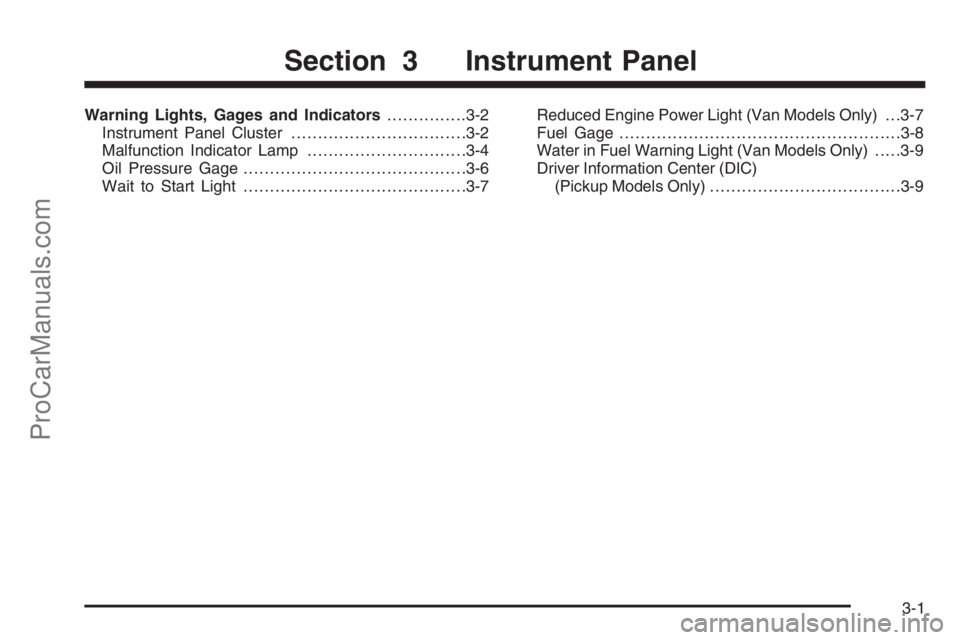
Warning Lights, Gages and Indicators...............3-2
Instrument Panel Cluster.................................3-2
Malfunction Indicator Lamp..............................3-4
Oil Pressure Gage..........................................3-6
Wait to Start Light..........................................3-7Reduced Engine Power Light (Van Models Only) . . .3-7
Fuel Gage.....................................................3-8
Water in Fuel Warning Light (Van Models Only).....3-9
Driver Information Center (DIC)
(Pickup Models Only)....................................3-9
Section 3 Instrument Panel
3-1
ProCarManuals.com
Page 15 of 100
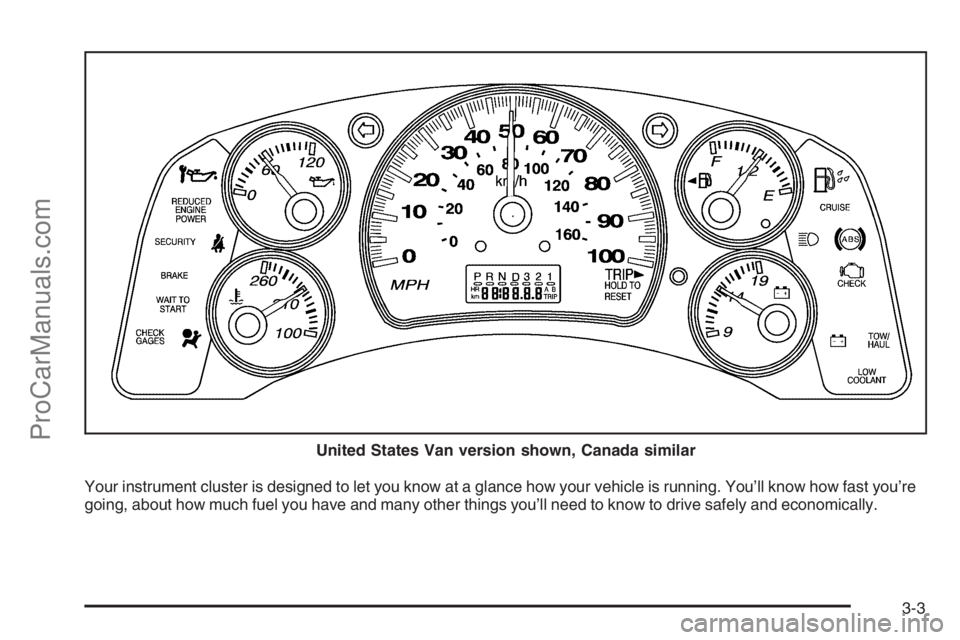
Your instrument cluster is designed to let you know at a glance how your vehicle is running. You’ll know how fast you’re
going, about how much fuel you have and many other things you’ll need to know to drive safely and economically.United States Van version shown, Canada similar
3-3
ProCarManuals.com
Page 16 of 100
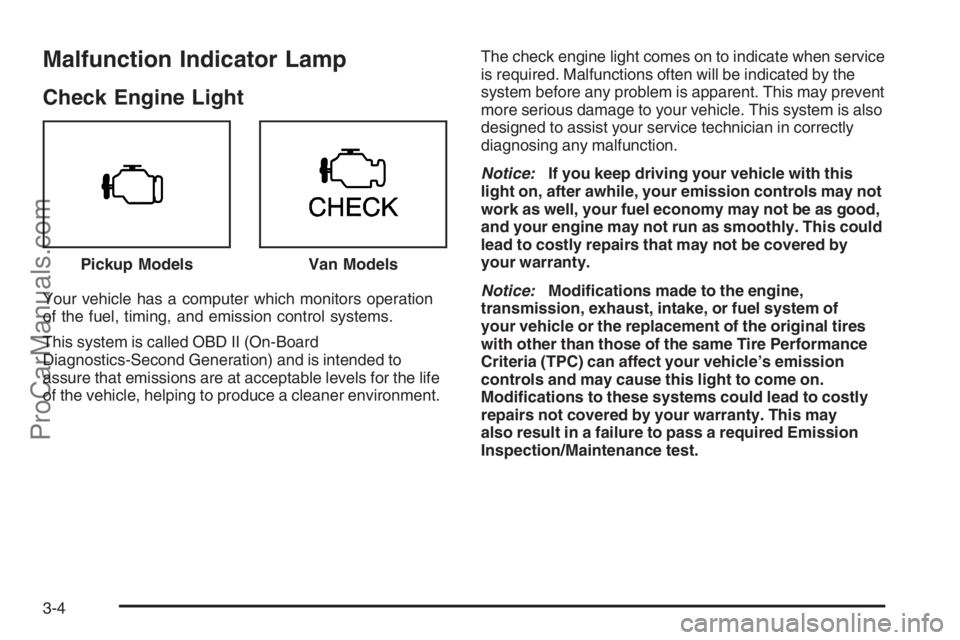
Malfunction Indicator Lamp
Check Engine Light
Your vehicle has a computer which monitors operation
of the fuel, timing, and emission control systems.
This system is called OBD II (On-Board
Diagnostics-Second Generation) and is intended to
assure that emissions are at acceptable levels for the life
of the vehicle, helping to produce a cleaner environment.The check engine light comes on to indicate when service
is required. Malfunctions often will be indicated by the
system before any problem is apparent. This may prevent
more serious damage to your vehicle. This system is also
designed to assist your service technician in correctly
diagnosing any malfunction.
Notice:If you keep driving your vehicle with this
light on, after awhile, your emission controls may not
work as well, your fuel economy may not be as good,
and your engine may not run as smoothly. This could
lead to costly repairs that may not be covered by
your warranty.
Notice:Modi�cations made to the engine,
transmission, exhaust, intake, or fuel system of
your vehicle or the replacement of the original tires
with other than those of the same Tire Performance
Criteria (TPC) can affect your vehicle’s emission
controls and may cause this light to come on.
Modi�cations to these systems could lead to costly
repairs not covered by your warranty. This may
also result in a failure to pass a required Emission
Inspection/Maintenance test. Pickup Models
Van Models
3-4
ProCarManuals.com